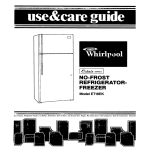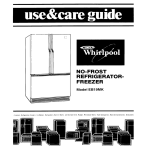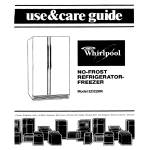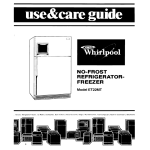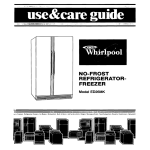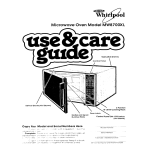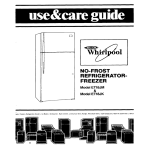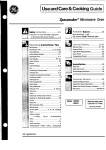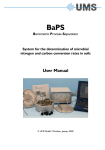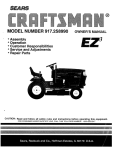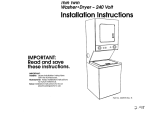Download Whirlpool ET22MT Specifications
Transcript
NO-FROST REFRIGERATORFREEZER Model ET22MT jrs, Freezers, Refrigerator-Freezers. Ice Makers, Dishwashers. Built-In Ovens and Surface Units, Ranges, Mlcrowave Ovens, Trash Compactors, Room Air Condltloners. Dehumldlfll Please read this Use and Care Guide before you do anything else... This booklet tells you how to start your refrigerator. clean it, move shelves and adjust controls. It even tells you what new sounds to expect from your refrigerator. Treat your new refrigerator with care. Use it only to do what home refrigerators are desrgned to do. Parts and features \ Tilt Ice* Dlspenser Alr Control DOOr Butter Compartment 0 Utility Compartment \ -Door Glass Shelves Hui Adjustable Shelves - Model and Serial Number Plate - Base Grille Copy your Model and Serial Numbers here... I When you need service or call with a question, have this information ready: Model Number 1. Complete Model and Serial Numbers (from the plate located as shown]. Serial Number 2. Purchase date from sales slip. Purchase Copy this information in these spaces. Keep this book, your warranty and sales slip together in a handy place. 2 Service Date Company and Telephone Number *Tmk Contents Page BEFORE YOU PLUG IT IN Install Properly Level Refrigerator-Freezer Remove Soles Labels Clean It Plugltln ,.,..,., ,,.,, ,.,, ,, ,, USING YOUR REFRIGERATOR Setting the Controls Power Saving Control Changing the Control Settings Tilt Ice* Dispenser Adjusting Meat Pan Temperature Removing the Meat Pan Adjusting Crisper Humidity Control Removing Crispers and Crisper Covers Adjusting Shelves Page 3 4 4 4 4 4 5 5 5 5 6 6 6 7 7 7 Changing Light Bulbs Sounds You May Hear Energy Saving Tips CLEANING YOUR REFRIGERATOR Removing the Bose Grille Cleaning Chart FOOD STORAGE GUIDE Storing Fresh Food Freezing and Storing Frozen Food VACATION AND MOVING CARE IF YOU NEED SERVICE OR ASSISTANCE I, Before Calling for Assistance 2. If You Need Assistance 3. If You Need Service 4. If You Hove o Problem 7 8 8 8 8 9 10 10 11 14 15 15 15 15 15 01983 WhIrlpool Corporation Before you plug it in IMPORTANT Before using your refrigerator, you ore personally responsible for making sure that it... l is installed and leveled on o floor that will hold the weight, and in on are0 suitable for its size and use. l is connected only to the right kind of outlet, with the right electric supply and grounding. l is used only for jobs expected of home refrigerators b is not near on oven, radiator or other heat source. ‘TMK l l l l l l is properly maintained. is out of the weather. is used in on area where the room temperature will not fall below 55” F (13°C). is not run where there ore explosive fumes. is not used by children or others who may not understand how it should be used. is not loaded with food before it has time to get properly cold. 3 Install proI ,erly.. . i- Remove sales labels.. . Remove the Consumer Buy Guide label and other inside labels before using the refrigerator. Any glue left can be taken off with rubbing alcohol IL1,1L_i Clean it.. . T-k - - For ease of installatron allow 92” [ 1.25 cm] space between counters and cabinets and the sides and top of the refrigerator. The refrigerator back can be flush against the wall. If the refrigerator is to be against a wall, you might want to leave enough space so the door can be opened wider. Level refrigerator-freezer.. . Clean your refrrgerator before ing instructions on page 8. using it. See clean- Plug it in... wall receptacle Use Screwdriver Refrigerator Power Cord Recommended Grounding Method Right to Raise; Left to Lower I, 2. 3. 4. Remove base grille (see page 8). To raise front, turn each screw to the right. To lower front, turn each screw to the left. Check with level. A 115 Volt, 60 Hz., AC only, 15 or 20 ampere fused electrical supply is required. It is recommended that a separate circuit serving only this appliance be provided. Do not use an extension cord. Use a receptacle which cannot be turned off with a switch or pull chain. See individual electrtcal requirements and groundrng instruction sheet in your literature package. Using your refrigerator Power Saving Control Temperature Setting the controls.. . COntrOlS for the refrrgerator and freezer are In the refrigerator. When the refrrgerator ,S plugged In for the first trme. yc@ @ 3 1 Set the TEMPERATURE CONTROL to 3. s ’ 2. Set the AIR CONTROL to B. Air Control Air Outlet Control Give the refrigerator time to cool down completely before adding food. (Thus may take several hours.) These settings should be about right for normal household refrigerator usage. The controls WIII be set about right when milk or juice is as cold as you like and when Ice cream IS firm. Do not block the air outlet on the control panel. Blockrng it can slow the air movement needed to keep temperatures at the level you set - Power Saving Control.. . The Power Saving Control on the Control Console operates electrrc heater around the door openings. These heaters help keep moisture from forming on the outside of the refrigerator. 1. Use the “OFF” setttng when humidity ISlow 2. Use the “0N”settrng if moisture forms on the outside of the refrigerator Changing the control settings.. . If you need to adjust temperatures in the refngeratof or freezer, use the settings listed In the chart below. CONDITION : If Refrigerator Sectron is TOO WARM If Freezer Section IS TOO WARM ---- QUESTIONS? .,.call your If Refrigerator CooL-L’NE ’ Section IS service TOO COLD assistance If ICE isn’t telephone MADE FAST ENOUGH number @age 15). YZZKKCTIONS are TOO WARM -_I.- ---_- -Pm-~--“... l l l Adjust the Temperature Control first. Wait at least 24 hours between adjustments. Then adjust the Air Control, if needed. REASONS: Door opened oftenLarge amount of food added Room temperature too warm --, Door opened often Large amount of food added Very cold room temperature [can’t cycle often enough] Controls not set correctl; for your ccndittons RECOMMENDED SETTINGS: -,.---l.l~.-..r-I 4 Temperature Control C Arr Control - _~.-_.~ -,.-.--I Temperature control Air Control ~..^-__----..-“,xT Temperature Control Arr Control ..-~.I i ,I. ---.----.-_..__.-I--_. Temperature Control Heavy ice usage Air Control Very cold roorr temperature [can’t cycle often enough] 1 c--_ .. Te?iii?a6%-~ontrol Door opened often Air Control Large amount of food added Very warm or very cold room temperatures ~-__~ ....-- ~.l,z .._ -_,., ~,“__,~ _-___ _._.___ ___._ x_ _ 2 B J A 4 B 5 Tilt Ice * Dispenser.. . Adjusting There are a few things you’ll want to know about the Ice btn and the automatic ice maker that fills it. l Bin is inside small door on freezer doof l To open Tilt-Ice’ DisDenser Door, lift I up’on handle, tilt door down. l Reach in, pull bin out part way or remove it from freezer. l If you remove bin, I STOP ice maker. Open freezer door and push lever to OFF. Push it back ON when you replace bin. Cold air flows into the meat pan container through an opening in the back of the refrigerator. This helps keep the meat pan colder than the rest of the refrigerator Set the control meat pan temperature.. . to let more or less cold air through Removing the meat pan.. . The meat pan, shelf and container can be reit must moved for cleaning. When it is reploced, o/ways be /n the some position ON /OFF lever is under front panel 1, Slide meat pan out. l l l You ~111hear water filling the mold and ice cubes falling into the bin. These are normal sounds. The Ice maker WIII stop automatically when the bin is full. It will start again when you remove ice. Shake bin occasionally to keep cubes separated. l l l Tips, New plumbing connectlons can give the first cubes an odd taste or color. Just throw these away. The Ice maker will refill the bin Cubes stored too long may develop an offflavor...like stale water. Throw them away. Cubes stored for more than a few weeks will become smaller because moving air in the freezer is so cold that it starts a slow evaporatton If you use Ice often, you may never notice shrinkage. 2. Tilt shelf up ot front 3 Pull straight out. 7. Turn the COLD to avoid the refrigerator section while the ’ meat pan IS removed. To replace (The meat pan container must be replaced in the same position): 1 Position container so that opening fits overcoldair Inlet. Guide rear hooks into slots IP shelf supports Ttlt up front of container until hooks drop into slot. Lower container to level posItIon. 2. Replace shelf over container. 3 Slide meat pan back Into container 4. Reset meat pan temperature control to desired setting. 6 Tmk Adjusting crisper Humidity Control.. . Adjusting You con control the amount of humidity In the moisture-sealed crisper pan. 1. The control can be adjusted to any setting between LO and HI 2. LO (open] lets moist air out of crisper for best storage of fruits and vegetables with skins. 3. HI (closed) keeps moist air in the crisper for best storage of fresh leafy vegetables. 11 / a..,, -L/ 7 .‘1 : , i , __.”..=. ._ r* .h’ .r.Y .,‘? Gloss shelves l l l u heovy Be coref To replace: 1. Guide the rear hooks into the slots in the shelf supports. 2. lilt up front of shelf until hooks drop into slot. Lower front of shelf to level posttion. Removing the crispers and crisper covers.. . l shelves.. . Shelves can be adjusted to match the way you use your refrigerator. Glass shelves are strong enough to hold bottles, milk and other heavy food items. To remove glass shelves: 1. Tilt up at front. 2. Lift up at back. 3. Pull shelf straight out. To remove door shelves: l Lift up and out Slide crispers straight out to stop. Lift the front. Slide the rest of the way out. Replace in reverse order. To replace: l Insert hooks into guides on both sides. l Push down. Covers are held in place by two pegs at the back and two notched tabs in front. h-7 4 :*v%;is , I.” 1c .A4 i : si4 &. Changing the light bulbs... Push the Tab to Clear the Cover. Before removing the light shield for cleaning replacing the bulb, unplug the refrigerator. apphance buibs on/y or for Use ush in the Center; ull Down. l Press front tabs out of the way. 0 Lift cover front. l Lift back off the pegs. l Replace in reverse order. l The center leg can be made shorter or longer to help level the crisper covers, if necessary. Turn the leg clockwise to make it longer. Turn it counterclockwise to shorten it. l l Light bulb behind light shield: l Push lightly on the top center of the light shield until the notched tab unhooks from the control panel. l Pull down on the shield until the tab clears the control panel. l Lift the bock hooks out of their slots. l Replace with a do-watt appliance bulb l Replace light shield in reverse order. light bulb behind ice maker: l Remove the ice bin [see ice maker instructions on page 6). l Replace with a 40-w&t appliance bulb. OReplace ice bin. Ught bulb behlnd crispers: l Remove crispers and crisper covers. l Bulb is on back wall of refrigerator. l Replace with a 40-watt appliance bulb. l Replace crisper and crisper cover. l Plug in the refrigerator. 7 Sounds you may hear.. . ‘5 P 3 ’ ,c Possible Sounds: l Slight Hum, Soft Hiss: Clicking Sounds: l or Snapping Water Sounds: l l Ice Maker l Running Sounds: Sounds: Your new refrigerator may make sounds that your old one didn’t. Because the sounds are new to you. you might be concerned about them. Don’t be. Most of the new sounds are normal. Hard surfaces like the floor, walls and cabinets can make the sounds seem louder. The following chart describes the kinds of sounds that might be new to you. and what may be making them. _.~ ..~ Probable Causes: Your refrigerator has two fans; you may hear the fan motors_-and moving l.__.“.._~., air. -- . -1 .-~.I_- . -.5 -* 1 The defrost timer makes a definite click when the refrigerator stops running. It also makes a sound when the refrigerator starts. .i_- -,. When the refrigerator stops running, you may hear gurgling in the tubing for a few minutes after it stops. You may also hear defrost water running into the defrost water pan. -.-. II_ You may hear a buzzing (from the water valve), trickling water and the clatter of ice dumped into the brn. -- ^__.. -_ e-,.-m- Your refrigerator has a high-efficiency compressor and motor. It will run longer than older designs. It may even seem to run most of the time. ., Energy saving tips.. . l It is a waste of electricity to set the refrigerator and You can help your refrigerator use less electricity. Check door gaskets for a tight seal. Level the cabfreezer to temperatures colder than they need to inet to be sure of a good seal. be. If ice cream is firm in the freezer and drinks are as cold as your family likes them, that’s cold l Clean the condenser coil regularly, l Open the door as few times as possible. Think enough. l Keep the Power Saving Control on OFF unless about what you need before You open the door. Get everything out at one time. Keep foods orgamoisture forms on the refrigerator exterror. l Make sure your refrigerator is not next to a heat nized so you won’t have to search for what you source such as a range, water heater, furnace, want. Close door as soon as food is removed. l Go ahead and fill up the refrigerator, but don’t radiator, or in direct sunlight. overcrowd it so air movement is blocked. - ,. ., .: ... , ;“, l Cleaning your refrigerator.. Both the refrigerator and freezer sections defrost automatically. But both should be cleaned about once a month to help prevent odors from building up. Of course, spills should be wiped up right away. To clean your refrigerator, turn the Temperature Control to OFF, unplug It. take out all removable parts, and clean tt according to the following drrections. . Removing the base grille... l Open the doors. l Do not remove l 8 l l Tech sheet fastened behind grille Line-up grille support tabs wrth metal clips. Push firmly to snap into place. Close the doors. :, Cleaning chart.. . ..---.--. .__” --.- ~ .._-._-,,.- _I ^I____.__OYI_-.n- Part .--.-1--~------- ._-..__Removable parts (shelves, crisper, meat pan etc.] .-.,.-- _.-I-_---__-_-._I-r_ Outside Mild detergent warm water .,.. and ,____.-_.-.- -__--..I..~ Sponge, cloth or paper towel; mild detergent; appliance wax [or good auto paste wax). Waxing Inside walls (Freezer should be allowed to warm up so cloth won’t stick.) _-.- What to use painted metal Sponge, soft cloth or paper towel, baking soda, warm water, mild detergent. ----.I ...~__--_l.j-. How to clean _I-_,_ .-_1-__1 l Wash removable parts with warm water and a mild detergent l Rinse and dry - I_---l Wash with warm water and a mild detergent. Do not use abrasive or harsh cleansers. l Rinse and dry l Wax painted metal surfaces at least twice a year with appliance wax or a good auto paste wax. Apply wax with a clean, soft cloth. Do not use wax on plastic parts. surfaces l l Door liners and gaskets -.-mm- .---“-._. ..-- .. -_.l.._;_.l__ll Dark panels Sponge, soft cloth or paper towel; mild detergent, warm water DO NOT USE Cleaning bleaches or cleansers __, Mild detergent and warm water; soft, clean sponge and soft, clean cloth. l l provides rust protection. -.___II Wash with warm water and -mild detergent or -baking soda (2 tablespoons 1 quart [.95 I] warm water Rinse and dry Wash with mild detergent water Rinse and dry and warm waxes, concentrated detergents, containing petroleum on plastic l l [26 g] to parts. Wash with a soft grit-free cloth or sponge. Rinse and dry wrth a damp grit-free cloth or chamois DO NOT USE paper towels, window sprays, scouring cleansers, or solvents like acetone, benzine, carbon tetrachloride, etc. These can scratch or damage the material. Defrost pan Condenser Remove base grille. [See page 7.) To remove defrost pan, lift pan over wire brace [remove tape; if any). l Wash defrost pan with warm water and mild detergent. l Rinse and dry l Replace with notched corner to the rear. l Push it all the way in. l Make sure defrost drain tube is pointing into pan l Replace base grille. -1---e -w-m-?.-- -.----II l Remove base grille. Vacuum cleaner; using the extended narrow l Clean dust and lint from condenser at attachment. least every other month. l Replace base grille. . ____-_-___,___ -.. Usual floor cleaners. l Roll refrigerator out only as far as water supply line allows . Wash floor l Roll refrigerator back. l Check to see if the refrigerator is level. Warm water and mild detergent. Coil j.i._. I,.1 - “-_ -^ - ._,_ -.__ _.Floor under refrigerator l l Food storage guide STORING FRESH FOOD Cured or Smoked Meat and Cold Cuts. Ham, bacon. sausage. cold cuts. etc keep best in original wrapplngs Once opened, tightly re-wrap in plastic wrap or aluminum foii Canned Ham. Store In refrigerator unless the label says its okay to store on the shelf Do not freeze Fresh Poultry Looseiy wrap n waxed pope: or plastic &rap The plastic *‘rap on, poultry as purc hosed, may be used for storage STORAGECHART FOR FRESHAND CUREDMEAT* Approxlmate Time Wwl Variety Meats . . . . . . . . . . . . . . . . . . . . it02 Chicken . . . . . 1 to2 1 to 2 Ground Beef . . . . . . . . . . . . . . . Steaks and Roasts . . . . . . . . . . . . 3 to 5 Cured Meats . . . . . . . . . . . . . . . . . . . . 7 to10 Bacon . . . . . . . . . . . . . . . . . . . . . . . . . . . . 5to7 ColdCuts . . . . . . . . . . . . . . . . . . . . . . . . 3to5 rVPe There IS a right way to package and store refrrgeroted or frozen foods To keep foods fresher, longer, take the time to study these recommended steps Leafy Vegetables Remove store droppIng Trim or tear off bruised and discolored areas Wash In cooi water, drain and store In crisper Cord moist air helps keep leafy vegetables fresr and crisp The crispers hove sealing gaskets to nelp keep humId olr in They also hove a control to help adlust the amount of humidity in the crispers Vegetables with Skins (carrots peppers) Store n crisper, plastic bags or plosttc container Wash, let dry ond store or refrigerator in Fruits plastic bogs or crisper Do not WCIS~I or hull berries untlr they are reads to ‘use Sort and keep berries Itheir store container in a cr’sper or sore in o IOOseiV closea paper bag on a refrlgerotor shelf Meat IS perrshable and expensive you Meat won’t want to waste an ounce of It through careless hondlrng The following list and chart give you packaging hints and time limits Store meal ir the meat pan Fresh, Prepackaged Meat. Store fresh meet in the store wrapping Vacuum packaged meat con be frozen for OS long OS one morth sf the sea’ 1s not If you wont to keep it frozeri longer vou broken should wrap it with special freezer;Nropprng moteriol Fresh Meat, Not Prepackaged. Remove tne market wrapping paper and re-wrap looselv n waxed paper or aluminum foil for storing it unfrozen Cooked Meat. Wrap or cover cooked meat with waxed paper, plastrc wrap or aluminum foil Store immediately 3 *If meat is to be stored longer than the times given, follow the directlons for freezing. NOPE: Fresh fish and same day shellfish should be used the as purchased Eggs Store without washing in the orrginai carton or use the Utlllty Bin that came with your refrrgerator Milk Wipe ml/k cartons For best storage place milk or- InterNor shelf Beverages \r\/,pe bottles and cans Store on, a aoor shelf or nIside the refrigerator Butter Keep opened bu’ter ,r covered dish or or ‘he Butter Compartment When storrng an extra supp y wrcp r freezer poclaglng and freeze Store in the orrginal wrapping until Cheese you are ready to use it Once opened re-wrap trghtly in plastic wrap or aluminum foil Store small jars and bottles (catCondlments sup, mustard, jelly olrves) on the door shelves where they are in easy reach Leftovers Cover leftovers with plastic wrap or out and aluminum fo to keep focx2 from drying tronsferrlng fboa odors Plastic cortalners v*i’lth) trght ‘ids ore fine too FREEZING & STORING FROZEN FOODS 3 6 -he freezer sectIon IS ceslgned for storage rf corn merc~cllyJ frozen focas orrj for ‘reezIng fcods af nome Packaging-The secret of successful freezlng IS In the packaging The wrap you use must be ar moisture and vapor proof The way you close and seal the package must not allow err, morsture or vapors in or out RIgid polyethrylene (plastic) containers with tightfitting lids, straight-sided canning freezing jars, heavy-duty aluminum fori, plastlc-coated paper and non-permeable plastrc wraps (such as satan] are recommended Note Heat-sealed bolllng bags are easy to use and can be used by themselves or as carton 9ners Sealing ~ Wher, sealing out the air (liqurds reed foods r bags “eadspace to exporsion 1 TWS the tab ana turn it bock securely around the aoubled-over t& put inside transporert bags ‘JSe se;f-achesNL,e outsde of opaque ones squeeze o~lo:~ for Faster ?le ‘he !ocel lobe1 or, Air-tight wrapping COIIS ‘or drugstore wrap Cut the sheer about one-third longer than the distance around the food Bring the ends together and foid r (toward the food) at least twice to seal out air Crease ends close to food, press ar froT puc*oge FSc! tips aver twce Fir ST package arc tope e’osed Nb-E With Jnboned meats, pod srlaru edges ‘&It” extra ‘he &rap from ~wT~p or LJSe stock -;e:*e tc protect punctures DO NOT USE, 0 Bread wrappers l Non-polyethylene plastic containers l Containers without tight lids 0 Waxed paper l Wax-coated freezer wrap l Thin, semi-permeable wrap None of these are totally moisture, air or vapor proof. Freezing Fruits - Se ec+ ripe b emsh-free frul+s Be sure they ‘oste as good OS thev IOOK Wosn 2 to 3 quarts [liters) a+ CI +lme on3 drain Fru t that stands lr ‘wVater ma\/ lose food value ord Serome soggy Sort oeel. trim glt ant slice as needed Pock r, rNgId ;vlde-mou+hea cortoiners or other recommended ?la:eriol Leave head space tc al13~ i gc~ ds to exporx durirg freezlr,g 11 Freezing Vegetables -Freeze only fresh highquality vegetables ptcked when barely mature For best results, freeze no more than 2 to 3 hours after ptckrng. Wash In cold water, sort and cut into appropriate srzes. Blanch or scald. Pack in recommended container and freeze. Do not freeze lettuce, celery. carrot sticks, potatoes or fresh tomatoes All WIII become lrmp or mushy. Tomatoes will collapse when thawed Freezing Cooked Food-Prepare cooked foods as you would for the table; shorten cookrng timel0to15m~nutestoallowforadd~t~onal cooking during reheatrng. Omit seasonings and part of the Irquid. Plan to add them at reheating time. Potatoes should also be added to soup and stew at heating time. Add crumb and cheese toppings at heating time Cool as raprdly as possible and freeze at once. Liquid or semi-liquid dishes may be frozen in recommended containers with heed-space Casseroles and other more solid foods may be frozen in the baking container. If you don’t want to leave your casserole dish tn the freezer, line It wrth forI Bake. cool, freeze, lift out the foil package. bag rt and return to freezer . Freezing Meats-The meat you thaw can only be as good as the meat you freeze. “Drugstore” wrap In meal-size packages. Flat cuts or pattles should be wrapped Individually or In layers separated by a double thrckness of freezer wrap. Make sure store wrappings are moisture and vapor proof. If not, re-wrap meats with one of the wraps recommended under “Packagrng” Freezing Baked Goods -Wrap baked breads in recommended material Thaw in wrapping. Unbaked yeast breads can be frozen after the first rrsrng. Punch down, wrap and freeze. Bake cookies as usual. Cool and freeze on trays. then pack in recommended freezer bags or cartons Unbaked cookies may be dropped, molded or rolled and frozen on cookie trays. Store in bag or carton, bake without thawrng. Refrigerator-type cookies can be wrapped and frozen in roll form Thaw only enough to slice when ready to bake Fruit pies are best frozen unbaked Bake without thawing Bake pecan and similar pies before freezing .rrch frllrngs do not freeze solid Cut steam vents in top crusts when ready to bake. 12 IMPORTANT: Do not expect your freezer to quick-freeze any large quantity of food. Put no more unfrozen food into the freezer than will freeze within 24 hours. (No more than 2 to 3 pounds of fresh meat or 3 to 4 pounds of vegetables per cubic foot of freezer space.) Leave enough space for air to circulate around packages. Be careful to leave enough room at the front so the door can close tightly. FOODSTORAGECHART Storage times* will vary according to the quality of the food, the type of packaging or wrap used (moisture and vapor-proof), and the storage temperature which should be 0” F (-17.8”C). Storage time Food FRUITS Fruit juice concentrate . . . . . 12 months Commercially frozen fruit . . 12 months Citrus fruit and juices. . . . 4 to 6 months Others . . . . . . . . . . . . . . . 8 to12 months VEGETABLES Commercially frozen . . . . . . . 8 months Home frozen . . . . . . . . . . . 8 to 12 months MEAT Bacon . . . . . . . . . . . . . . 4 weeks or less Cornedbeef . . . . . . . . . . . . . . . . . 2weeks Cured ham . . . . . . . . . 1 to 2 months (Salting meat shortens freezer life) Frankfurters . . . . . . . . . . . . . . 1 month Ground beef, lamb, veal 2 to 3 months Roasts: Beef . . . . . . . . . . . . . . . . . 6 to 12 months Lamb and veal . . . . . . . 6 to 9 months Pork . . . . . . . . . . . . . . . 4 to 8 months Sausage, fresh . . . . . . . . , . 1 to 2 months Steaks and chops: Beef . . . . . . . . . . . . . . . . . 8 to12 months Lamb, veal, pork . . . . . . 3 to4 months FISH Cod, flounder, haddock Sole.. . . . . . . . . . . . . . . . . . . . . 6 months Blue fish, salmon . . . . . . . . 2 to 3 months Mackerel, perch . . . . . . 2 to 3 months Breaded fish (purchased) . . . 3 months Clams, oysters, cooked fish, crab, scallops . . . . 3 to4 months Alaskan king crab . . . . . . . . . 10 months Shrimp, uncooked . . . . . . . . 12 months POULTRY Whole chicken or turkey.. . . 12 months Duck . . . . . . . . . . . . . . . . . . . . . . . . 6months Giblets . . . . . . . . . . . . . , . . . 2 to 3 months Cooked poultry w/gravy . . . 6 months Slices (no gravy) . . . . . . . . . . . . 1 month Food Storage time MAIN DISHES Stews; meat, poultry and fish casserole . . . 2 to 3 months TV dinners.. . . . . . . . 3 to 6 months DAIRY PRODUCTS Butter . . . . . . . . . . . . . 6 to 9 months Margarine . . . . . . . . . . 2 to 9 months Cheese: Camembert, brick, Mozzarella, farmer’s . . . 3 months Creamed cottage . . DO NOT FREEZE Cheddar, Edam, Gouda, Swiss,etc. .. . . 6 to8 weeks Freezing can change texture of cheese. Ice cream, ice milk sherbet ... . . .. . 4 weeks EGGS Whole (mixed) . . . . . . 9 to 12 months Whites . . . . . . . . . . . . 9 to 12 months Yolks . . . . . . . . . . . . . . . . 9 to12 months [Add sugar or salt to yolks or whole mixed eggs) BAKED GOODS Yeast breads and rolls . . . . . 3 months Baked Brown ‘N Serve rolls . . . . . . . . . , . . . . . . . . . . 3 months Unbaked breads.. . . . . . . 1 month Quick breads . . . . . . . 2 to 3 months Cakes, unfrosted . . . . . . 2 to 4 months Cakes, frosted . . . . . . . 8 to 12 months Fruit cakes . . . . . . . . . . . 12 months Cookie dough . . . . . . . . 3 months Baked cookies . . . . . 8 to 12 months Baked pies.. . . . . , . . . . . 1 to 2 months Pie dough only . . . . . . . . . 4 to 6 months ‘Ekxecj ,a~ U.S DA suggested storage and Mlchlgan hmes Cooperai~ve Exlens~cm Service 2. If service 8s +o be mnterrupted longer +Wc 24 hoilrs (a, Remove aI1 frozer food and store lr a frozen food ocker Or (b Place aboti’ 20 pounds of ay Ice on 'Op nf ttie fooa &ng pieces as large 0s possable Protect your rlands with gloves ,c) If neither food locker Sorage nor cl,? ce IS avallaDle JSe or ca’ perIshable food at once 3. A fJi1 freezer ih’111stab co’3 ,3nger tna”I a partly fMea one 4 freezer fuii cf meat ~111 stay cold longer tbor a freezer full of baked goods If fooa contalrs Ice crystals ‘t may be safely refrozer,, o/though the qilaiSty and flavor may be affected Use refrozen foods quickly If ii7e condltlon of ihe fGGd IS poor or you hove any susDIcions. 8~Is hose +o dispose of I+ Vacation and Short vacations. . . Moving.. . NO need to shut off the refrigerator if you will be away for less than four weeks. Use up perishables; freeze other items. Turn off your ice maker; shut off the water supply; empty the ice bin and make sure all ice cubes are dispensed out of the mechanism. Shut off the ice maker water supply a day ahead of time. Disconnect the water line. After the last supply of ice drops, turn off the ice maker. Remove all food. Pack frozen foods in dry ice. Unplug the refrigerator and clean it thoroughly. Remove every-thing that comes out. Wrap all parts well and tape them together so they don’t shift and rattle. Screw in the levelling rollers; tape the doors shut; tape the electric cord to the cabinet. When you get to your new home, put everything back, and refer to page 4. Don’t forget to reconnect the water supply line. Long vacations. . . Remove all the food if you are going for a month or mote. At least a day ahead, turn off the water supply to the ice maker. When the last load of ice drops, turn off the ice maker. Unplug the refrigerator and clean it...rinse well and dry. Tape rubber or wood blocks to both doors . ..keeping them open far enough for air to get in. This will keep odor and mold from building up. Tape the blocks out of a child’s reach...do allow children near the refrigerator when doors are blocked oDen. To restart refrigerator, 14 not the see “Using Your Refrigerator.” QUESTIONS? .call your COOL-LINE@’ service assistance telephone number If you need service or assistance, we suggest you follow these four steps: 1. Before calling for assistance.. . Performance problems often result from little things you can find and fix yourself without tools of any kind. If your refrigerator will not operate: Is the electric cord plugged in? l Is a fuse blown or a circuit breaker tripped? l Is the Temperature Control turned ON? I~ there Is a rattling or Jlngllng noise, or other unfamlllar sounds: l Is something on top or behind the refrigerator making noise when the refrigerator is running? l New features on your new refrigerator make new sounds. You may be hearing air flowing from the fans, timer clicks for the defrosting cycle, defrost water draining into the defrost pan. If your ice maker will not operate: l Has the freezer had enough time to get cold? With a new refrigerator, this might take overnight. l Is the signal urm ON,, .in the down position? l Is the water valve turned on? Is water getting to the ice maker? and talk with one of our trained Consultants. The Consultant can instruct you in how to obtain satisfactory operation from your appliance or, if service is necessary. recommend a qualified service company in your area. l If there Is water In the defrost pan: l In hot, muggy weather, this is normal. The pan can even be half full. Make sure the refrigerator is level so the pan doesn’t overflow. If the lights aren’t working: l Check fuses and circuit breakers. Make sure it’s plugged in. If a bulb Is burned out: l See instructions for changing light bulbs on page 7, Use appliance bulbs only. If the motor seems to run too much: l Is the condenser, behind the base grille, free of dust and lint? l On hot days, or if the room is warm, the motor naturally runs longer. l If the door has been opened a lot, or if a large amount of food has been put in, the motor will run longer to cool down the interior Remember: Motor running time depends on different things: number of door openings, amount of food stored, temperature of the room, setting of the controls. And, your new refrigerator may be larger than your old one so it has more space to be cooled. It also has a regular freezer instead of a frozen food compartment, All this means better refrigeration and may require more running time than your old one. 3. lf you need service*... Whirlpool has a nationwide network of franchised TECH-CARE * Service Companies. TECH-CARE service technicians are trained to fulfill the product warranty and provide after-warranty service, States. To locate TECH-CARE service in your area, call our COOL-LINE service assistance telephone number (see Step 2) or look in your telephone directory Yellow Pages under: APPLIANCES-HOUSEHOLDMAJOR-SERVICE L REP*IR WHIRLPOOL APPLIANCES FRANCHISED TECH-CARE SERVICE SERVICE XYZSERVICE CO 123Map1e OR COMPANIES WHIRLPOOL APPLIANCES FRANCHISED TECH-CARE SERVICE SERVICE XYZ SERVICE CO. 123 Maple 999-9999 COMPANIES 999.9999 OR WASHING MACHINES, A IRONERS-SERVICING DRVERS WHIRLPOOLAPPLIANCES FRANCHISED TECH-CARE SERVICE SERVICE XYZ SERVICE CO. 123Maple, COMPANIES 999-9399 4. If you have a problem*. . . Call our COOL-LINE service assistance telephone number [see Step 2) and talk with one of our Consultants, or if you prefer, write to: Mr. Guy Turner, Vice President Whirlpool Corporation Administrative Center 2000 US-33 North Benton Harbor, Ml 49022 “If you must call or write, please provide: model number, serial number, date of purchase, and a complete description of the problem. This information is needed in order to better respond to your request for assistance. 2. If you need assistance*. . . Call Whlrlpool COOL-LINE” service asslstance telephone number. Dial free from: Contlnental U.S. . . . . . . . . . . . . (800]253-1301 Mlchlgan . . . . . . . . . . . . . . . . . . . (800) 632-2243 . . . . . . . . . . . (800) 253-1121 Alaska 6 Hawall ELECTRICAL APPLIANCESMAJOR--REPIIRINCI & P*RTS 0 FSP Q FSP IS a regIstered trademark of WhIrlpool Corporotlon for quollty parts Look for this sVmbol of quallh/ whenever you need a replacement part for your Whirlpool appliance FSP replacement parts will fit right and work right.. because they are made to the same exacting specifications used to build every new WhIrlpool appliance 15 Making your world a little easier. Part No. 943044 Rev, 6 0983 Whirlpool Corporation ce Makers. Dishwashers. Bull-In Ovens and Surface Un~ls. Ranges. Mwowave Printed in U.S.A. Ovens. Trash Compactors, Room AM Condltloners. Oehumldifiers. Automattic Washers, Clothes Dry(
















